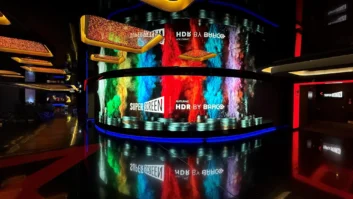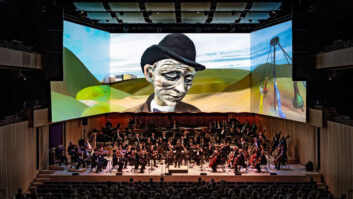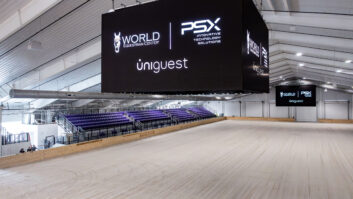If you take any interest at all in the cinema, you’re probably familiar with The Blair Witch Project, a low-budget horror movie that, in the style of a documentary, told of a group of amateur film-makers who set off into the wilderness in search of a mythical creature – and people get killed. Most movie fans, however, are unaware of the fact that a virtually identical movie – a low-budget horror film, in the style of a documentary, in which amateur film-makers set off into the wilderness in search of a mythical creature (and people get killed) – was made a year earlier. However, The Last Broadcast didn’t achieve fame or recognition as a forerunner of The Blair Witch Project. It achieved that by virtue of the fact that, on 23 October 1998, it became the first feature film to be created digitally, to be distributed digitally (via satellite, in this case) and to be screened digitally. As such, digital cinema can claim to be just about 10 years old.
It was also a decade ago that Texas Instruments began the development of its DLP Cinema technology – a variant of its DLP projection technology, specifically optimised to replicate the viewing experience of film – with the first demonstration (of Star Wars: Episode I – The Phantom Menace) taking place on 18 June 1999.
Since then, as Dan Goldstein pointed out (see IE Februar y 2008, page 40) digital cinema has become an increasingly pervasive reality thanks in no small part to a business model – the virtual print fee (VPF) – having been devised that is acceptable to the Hollywood studios, distributors and exhibitors. No less important, however, in the development of digital cinema has been the need to reach agreement on technical standards in the areas of image and sound quality, reliability, security and interoperability.
It was to address this requirement that Digital Cinema Initiatives (DCI) was formed in 2002, a joint venture between MGM, Paramount, Sony Pictures, 20th Century Fox, Lions Gate, Universal, Walt Disney and Warner Bros. DCI released version 1.0 of its Digital Cinema System Specification on 20 July 2005 – and it is this, and its subsequent revisions, that has created the framework within which manufacturers supplying digital cinema equipment (to cinemas dependent on Hollywood-created content) are developing their products.
“Complying with standards is something equipment manufacturers have to do in all markets,” notes Blair Parkin, founder and managing director of consultancy Visual Acuity, “and it’s a way of creating a quality assurance for both the public and the studios.”
“Digital cinema has come through several evolutions since its inception in 1999,” says Tom Cotton, vice president of business development for Technicolor Digital Cinema. “The most important change to digital cinema has not been a technology change, but rather a philosophical one. The formalisation of the DCI specification in 2005 has paved the way for digital cinema in its current incarnation.”
“A key technology change that had begun to take place even before the DCI spec had been finalised was the creation of an interoperability group for digital cinema mastering,” he continues. “Initially an MPEG group, this development ensured digital cinema content made to a common formula could be played back on a variety of digital cinema (MPEG) servers. The DCI spec then proposed JPEG 2000 as its encoding format, and interoperability followed. Additional key technology decisions established by the DCI spec were the minimum resolution for projection at 2K (2048 x 1080), as well as the use of public and private keys to encrypt the content.”
“Perhaps the most significant change since the inception of digital cinema was the transition to JPEG 2000 as the accepted playback format,” notes Dr Man Nang Chong, founder and CEO of GDC Technology. “Digital cinema deployment began with different servers using their own proprietary compression and playback formats. Subsequently, the MXF Interop Group was formed to come up with a common MPEG-2 format that could be used by all the servers in the digital cinema industry. GDC is one of the founding members of this group. In June 2004, DCI announced that it had selected the JPEG 2000 image-coding system as the standard playback format. Naturally, the pre-existing digital cinema equipment had to be upgraded and reconfigured to support this new format.”
“One of the biggest changes we’ve seen has been the movement away from MPEG-2 as an imagecompression standard,” agrees Brian Claypool, senior director of product development for digital cinema at Christie Digital, “to the use of JPEG 2000 as the de facto image compression format for digital cinema, in accordance with the DVI specifications.”
“One of the advantages of encoding with JPEG 2000,” notes Jim Farney, who is Dolby’s director of marketing, motion picture, “is that it allows a single file to contain both 2K and 4K information.” Supporting a common encoding standard for the DCP – the Digital Cinema Package, which can be thought of as a ‘film can’ that contains all the information needed for a movie to be shown – is only one of DCI’s achievements. It has resulted not only in optimum interoperability but also a significantly lowered cost of production and distribution.
Decade of development
Other important changes in the past decade have been, inevitably, in digital cinema projection systems. The first demonstrations were conducted with a resolution of 1.3 million pixels. Texas Instruments went on to establish a baseline standard in March 2003 with its DLP Cinema technology (which is licensed to Barco, Christie Digital and NEC) of 2 million pixels – which is now the minimum required by the DCI specification. Relatively new entrant Sony (JVC having dropped out of the digital cinema picture with its D-ILA LCOS technology, after being an early player) offers its SXRD LCOS technology as an 8 million pixel solution which the company is promoting hard.
“4K is the preferred resolution at present,” smiles Oliver Pasch, head of digital cinema, Europe for Sony. “Our core advantage is the unique capability to deliver native 4K resolution as well as superior 2K playback with invisible picture structure. 2K is def initely not enough to keep the cinema experience ahead of any other type of movie presentation.” 2K and 4K are a reference to the number of pixels on the horizontal axis. But while resolution has been the most apparent change in projection technology, it’s far from the only one, as Barco’s product manager for digital cinema Raf Rentmeesters points out. “There have been important developments in the areas of user-friendliness, cost and reliability,” he says. “We now have operator-swappable standard lamps instead of customised ones, together with better user interfaces, a modular design and a single lens solution for all screens. On the cost front, TI’s 0.98in chip technology allowed the size of the optical system to be reduced, lowering costs – while the move to purpose-built digital cinema projectors, rather than adaptations of commercial high-brightness projectors that included unnecessary features such as image warping and ruggedisation – have also helped digital cinema projectors to become less expensive. And to ensure minimum downtime, we can now offer functionality such as redundant power supplies, userexchangeable modules and so on.”
It’s important to remember that, while the most visible use of digital cinema projectors is in the cinema, the increasingly digital nature of movie production sees them used throughout the process. “All three stages – production, post-production and exhibition – are affected by the emergence of digital technologies in cinema,” notes Claypool. “Christie’s primary commercial focus is on exhibitions, but we also support the use of DLP Cinema projection technology in production – for example, for screening dailies/rushes on location – and in post-production, such as supporting the propagation of the digital intermediate which uses DLP Cinema reference projector technology in the production process.”
“Over the past 10 years, performance has improved right across the system,” says Nancy Fares, business manager for TI’s DLP Cinema products group. “Resolution, brightness, colour gamut, system stability, data handling – those are just a few of the areas in which today’s digital cinema projectors are superior to their predecessors.”
Sounds good
But it’s not just about image quality. Few doubt the impact of sound on the overall movie-going experience. “With digital cinema, soundtracks can now take advantage of greatly expanded bandwidth compared with film,” says John Meyer, president and CEO of Meyer Sound.
“The high sample rate and bit depth of uncompressed linear PCM audio make possible greater intelligibility, richness and accuracy. Combined with increased surround sound channel counts, these improvements promise a level of sonic performance that’s simply not feasible in the home theatre environment. But to realise that promise requires sound systems that are able to deliver this enhanced sound to every seat in the theatre.
“As part of their digital cinema strategy, exhibitors should be looking to upgrade their audio systems, using high-power, low-distortion loudspeakers with a linear response. An upgraded sound system provides both an enhanced digital cinema experience, and allows for their venues to be used for other types of performances such as concerts or simulcasts.”
This continuing technology evolution seems inevitable – which raises the question, how can an industry standard such as the DCI specification be sustained and remain relevant? Today, for example, 2K resolution is the minimum specified resolution standard, a function, no doubt, of the fact that TI’s DLP Cinema technology – which hugely dominates the digital cinema projection landscape, accounting for over 7,000 installations – with its 2K resolution was already installed in several hundred cinemas by the time the first release of the DCI specification was made (and would reach over 1,000 a year later).
Mark Kendall, manager for business development and digital cinema at NEC Display Systems, refers to how DCI has ‘grandfathered’ the installed base – in effect, confirming that projectors already bought by cinemas are considered compliant. The answer, of course, is that while the DCI specification sets out minimum standards of performance and functionality that have to be achieved from the technology, it is rooted in the business need. It needs to tread a fine line between what is achievable, what is affordable – and what makes pragmatic sense. “Under the VPF model, the studios bear the primary cost of the digital systems, and the studios are the key members of DCI – so the challenges will be viewed from both a technical and a cost perspective,” notes Cotton.
The DCI specification has been described as something of a moving target – a description fuelled by the fact that version 1.1 apparently included no fewer than 148 errata, while version 1.2 (issued in March 2008) included a further 100. But that’s to misunderstand what’s going on, as Claypool points out. “Yes, the DCI system specification is a constantly changing set of requirements – because it recognises that technology, by its very nature, advances,” he says. “But, in addition, the specification is open to interpretation from a variety of sources – so many of the changes or errata that are issued are to clarify inconsistencies or ambiguities.” Remarkably, until fairly recently, it was possible to claim compliance with the DCI specification – but be unable to prove it.
In October 2007, DCI introduced a Compliance Test Plan, which brought with it some clarity. “The fact that the DCI specification has been a moving target has made it difficult for all digital cinema equipment manufacturers,” says Farney. “It is not a requirement of the DCI test plan that a manufacturer achieve 100% compliance in order to be deemed DCI-compliant. However, studios are free to request a copy of the certification results from each manufacturer. If a requirement that is deemed important by a studio is not met, the studio may refuse to supply content to play on that server. Therefore, Dolby intends to comply with all elements of the test plan so that customers can feel confident that studios will not refuse to supply content for playback on the Dolby server.”
Finally, in October 2008, DCI announced that it had signed licensing agreements for compliance testing with CineCert in the US, DMC/Keio University in Japan and Media Innovation Center in Italy. “These licensing agreements represent an important step in the maturing of the digital cinema marketplace. Through compliance testing, distributors, exhibitors, manufacturers and technology providers will have the assurance that equipment and products have been rigorously reviewed and comply with DCI requirements,” said DCI in its press release. Unquestionably, manufacturers have, on occasion, struggled to ensure DCI compliance – and, it seems, it has been an ongoing effort. “The real challenge arose in identifying a cost-efficient solution for existing customers to upgrade their equipment without having to replace the entire system,” notes Chong. “The need for prompt execution also came into play as the systems had to be upgraded in time for the release of upcoming digital titles.” The cost implication of keeping systems in the field updated is something that is also familiar to Pasch.
“There are a number of requirements that are technically challenging to implement,” says Farney. “Many of them add significantly to the final cost of the servers and projectors.” It’s a recurring theme: the industry is more than capable of doing what it takes to comply with the specification – but doing so without adversely impacting cost (in a very price-sensitive market) is the real difficulty.
www.alconsaudio.com
www.barco.com
www.christiedigital.com
www.dcimovies.com
www.dlp.com
www.dolby.com
www.gdc-tech.com
www.meyersound.com
www.nec-displaysolutions.co.uk
www.sony-europe.com
www.technicolor.com
www.ti.com
www.visual-acuity.com







